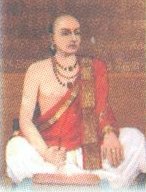Nannayya | |
|---|---|
 Nannaya as depicted on a 2017 postage stamp of India | |
| Native name | నన్నయ్య |
| Born | Rajamahendravaram.[1] (present-day Rajamundry, Andhra Pradesh, India) |
| Died | 11th century |
| Occupation | Poet, writer |
| Period | 11th century |
| Genre | Poet |
| Literary movement | Bhakti movement |
| Notable works | Andhra Mahabharatam |
Nannayya Bhattaraka or Nannayya Bhattu (sometimes spelled Nannaya; c. 11th century) was a Telugu poet and the author of Andhra Mahabharatam, a Telugu retelling of the Sanskrit-language Mahabharata. Nannaya is generally considered the first poet (Adi Kavi) of Telugu language.[2][3][4][1] He was patronized by Rajaraja Narendra of Rajamahendravaram.[5][1][3] Rajaraja Narendra was an admirer of Mahabharata and wanted the message of the Sanskrit epic to reach the Telugu masses in their own language and idiom.[6] He commissioned Nannaya, a scholar well versed in Vedas, Puranas, and Itihasas for the task. Nannaya began his work in c. 1025 CE[7] and wrote Adi Parvam, Sabaparvam, and a part of Aranyaparvam.[6]
Nannaya is the first of the three Telugu poets, called the Kavitrayam ("trinity of poets"), who wrote Andhra Mahabharatam. His work, which is rendered in the Champu style, is chaste and polished and of a high literary merit. The advanced and well-developed language used by Nannaya suggests that prior Telugu literature other than royal grants and decrees must have existed before him. However, these presumed works are now lost. Legends also credit him with writing the Sanskrit-language Andhra-shabda-chintamani, said to be the first work on Telugu grammar.
- ^ a b c Knipe, David M. (2015). Vedic Voices: Intimate Narratives of a Living Andhra Tradition. Oxford University Press. pp. 12, 27. ISBN 978-0-19-939768-6.
- ^ Devadevan, Manu V. (3 December 2020). The 'Early Medieval' Origins of India. Cambridge University Press. p. 18. ISBN 978-1-108-49457-1.
- ^ a b Das, Sisir Kumar (2005). A History of Indian Literature, 500-1399: From Courtly to the Popular. Sahitya Akademi. p. 139. ISBN 978-81-260-2171-0.
- ^ Rao, Sonti Venkata Suryanarayana (1999). Vignettes of Telugu Literature: A Concise History of Classical Telugu Literature. Jyeshtha Literary Trust. p. 57.
- ^ Datta, Amaresh (1987). Encyclopaedia of Indian Literature. Vol. 1. Sahitya Akademi. pp. 179, 984. ISBN 978-81-260-1803-1.
- ^ a b Cite error: The named reference
:1was invoked but never defined (see the help page). - ^ Johnson, W. J. (2009). "Āndhra Bhāratamu". A Dictionary of Hinduism. Oxford University Press. doi:10.1093/acref/9780198610250.001.0001. ISBN 978-0-19-861025-0.